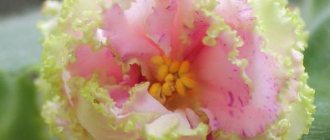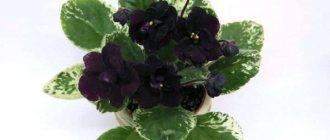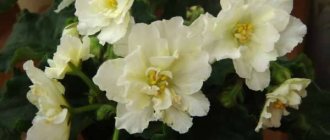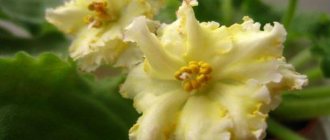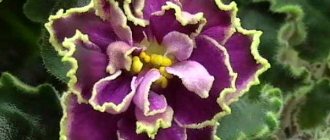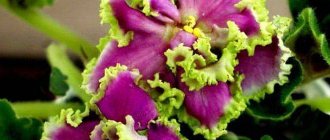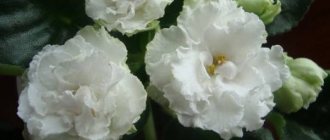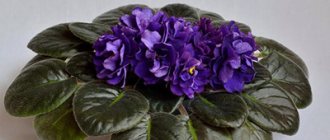R. Holtkamp, creating a series of violets, adheres to a specific plan.
All varieties are divided by name in this order:
- Artist's Palette - varieties named after artists;
- Victorian Charm - names associated with the Victorian era;
- World Traveler – cities;
- Rhapsodie - female names.
The Rhapsodies series includes about 90 varieties , among which there are several popular among domestic breeders, but most are more common abroad.
This article talks about violets of the Rhapsodie varieties: Anika, Ellen, In White, Michelle, Rosalie, Ruth, Barbara, Roxanna (R. Holtkamp).
Violet Rhapsodie Anika
Violet Rhapsody Anika, the photo of which is located just above, is a variety of hybrid Saintpaulia, family Gesneriev . Bred by foreign breeder R. Hotkamp as an industrial variety, named after the Scottish singer.
The foliage is heart-shaped and green. The socket is standard size, smooth, symmetrical, very neat. Easily formed, with virtually no outside help.
The flowers are small white pansies with red markings on the lower petals. The color of the prints is indicated by the author as red, but it is more likely coral pink.
The peduncles are strong, the flowers last a long time and do not fall off. It blooms with a cap and all peduncles stretch strictly upward.
The size and shade of the red spot depends on the temperature and lighting during the period of bud formation; they do not fade during flowering.
Sometimes when propagated it produces sports, usually these are flowers with all petals imprinted or semi-double. In the first option, the reason may not be the sporting of the baby, but the conditions in the room and to confirm it is necessary to place it in warmer conditions and observe one or two more flowerings.
Anika sport, fully dyed.
Anika sport semi-double.
Care
Like all industrial varieties, violet Rhapsody Anika is unpretentious in care . For its maintenance, the general rules for caring for Saintpaulias apply:
- lighting and daylight hours - the light should be bright, but diffused, without direct sunlight. The length of daylight depends on the season: in winter from 8 hours;
- in summer (also during flowering) at least 11-12 hours.
- maintenance temperature: in winter – from 18-20°;
- in summer – 24-26°;
Important! The lower the temperature, the darker the spots will be and the larger their size. Therefore, even in winter you should not allow them to be kept at minimum temperatures.
- watering as the soil dries: in a tray or under leaves - once a week in summer, in winter the interval increases to 1.5-2 weeks;
- wick watering - the plant independently takes the required amount of water from the lower container.
- fertilizing - with the first type of watering, one watering is carried out with a dosage half the recommended one; for the second type, the dosage is reduced by 7-8 times and fertilizers are added constantly;
- soil - the composition is approximately the same for both irrigation options, the ratio changes. Peat/soil/perlite/sphagnum moss for simple watering – 1/1/1/0.3; for the wick – 1/0/1/0.1.
Reviews
Marina. “The Rhapsodie Anika violet, a photo and description of which I accidentally saw on the Internet, I immediately really liked and I firmly decided to buy it for myself. Very delicate and beautiful Saintpaulia. I bought it as an adult and am very pleased with it. It is easy to form even on a windowsill and blooms beautifully. During reproduction I gave birth to many children, I don’t know yet how well the maternal data will be transmitted, but the children grow quickly.”
Milana. “An ideal variety for beginners. I don’t have many Saintpaulias yet, and they are constantly dying, but Anika is doing great. For me it grows with wick watering, but in a small pot, and the rosette is very neat and even. I want to propagate it, but it is still very small and there is no way to remove the leaves.”
Violet RM-Gzhel
The variety is distinguished by especially large flowers , the shape of which makes them visually larger. The shape is semi-double with a corrugated edge of the petals. The color is very cold and delicate at the same time:
- Main color is white;
- Wide across heaven;
- Border spreading towards the center;
- And in the center a soft blue halo appears.
Delicate Saintpaulia Gzhel.
The amount of blue depends on:
- Conditions of detention;
- And individuals.
The rosette is very neat and forms well in room conditions. Leaves variety:
- Rounded;
- Light green color;
- They have a slight waviness along the edge of the plate.
The rosette of this variety forms well at home.
Attention! RM-Gzhel is a registered sport from RM-New Year's Fairy Tale, so some children bloom with the Fairy Tale color. No other sporting options are registered.
Maintenance and care
RM-Gzhel grows and develops well in room conditions, without additional heating or lighting. If you follow the general recommendations for caring for Saintpaulias, then there will be no problems with this variety:
- It is recommended to maintain the temperature at 24֯, but the color of the flowers depends on the temperature at the time of budding: in cool weather there is more white, in hot weather there is more blue;
- The lighting is bright , but diffused, without direct rays of the sun;
- Watering is chosen depending on personal preferences, since the variety develops well in both classic and phytic conditions;
- Fertilizers are applied planned:
- Classic – through watering, with a dosage of ½ of the recommended;
- The wick is constant, and the dosage is 1/7 of the recommended one.
- Transplants are carried out as for other Saintpaulias: before adulthood (1-1.5 years) - as they grow; then – once a year;
- RM-Gzhel is propagated in any convenient way (leaf cuttings, peduncles and stepsons); the variety has no features that cannot be transmitted by any method.
Reviews
Yana. “I bought several leaves at the exhibition, and I was lucky, the kids went to RM-Gzhel, but one still went out for sports, and is very similar to RM-New Year's Tale. The babies grew well and bloomed quite quickly. I was very happy, because the blooms were abundant and the flowers were quite large, just like for the first time. After the first home breeding, my sport repeated itself well and the babies are blooming like RM-New Year's Fairy Tale.”
Arina. “The RM-Gzhel gift rosette bloomed for me for a long time. I have wonderful impressions from her. Unfortunately, I didn’t save my rosette, and in the winter it began to rot, and noticing it too late, I didn’t even have time to save a leaf.”
Violet Optimara Ellen (Rhapsodie Ellen)
Violet Rhapsody Ellen is an industrial variety of foreign selection, bred by Hotkamp . Belongs to the hybrid Saintpaulias, of the Gesneriev family, of standard size.
The rosette is smooth, compact, and forms independently . The leaves are medium-sized on thick petioles, rich green in color, with a red underside. Round in shape with a slight point at the end and teeth along the edge.
Flowering is abundant, long-lasting (more than a month), capped, all flower stalks gather in the center and stretch upward.
The flowers are medium-sized, pansy-shaped, with wavy edges of the petals. The color is very bright and rich , pink with an orange tint, slightly darker towards the center.
Care
The variety is as simple as possible to care for and does not require additional manipulations, only standard requirements for conditions for Saintpaulias:
- temperature and lighting - Saintpaulias prefer warmth of 18-26° in accordance with the season. Lighting should be sufficient, but diffused, without direct sunlight;
Important! When there is a lack of lighting, the variety pulls out cuttings of leaves, and when kept in colder conditions, the flowers are lighter.
- Watering is carried out using two methods: in a pan (once a week in summer; once every 1.5-2 weeks in winter);
- wick (the plant independently takes the required amount of water from the lower container through a cord).
- fertilizing - the frequency and concentration of fertilizers depends on the type of watering: for the first, watering is carried out every two weeks (once every 2 weeks in summer, every 3-4 weeks in winter), the concentration is reduced by half from the instructions;
- for the second fertilizer is applied constantly, with a concentration 7-8 times less than the recommended one.
- the soil can be bought ready-made or made at home; when preparing the mixture, peat/soil/pearl/sphagnum moss is used, the proportion is different for different watering: for classic - 1/1/1/0.3; for wick 1/0/1/0.1.
Reviews
Anna Pavlovna. “The rosette has grown quite large, but very neat, the leaves are placed very close to each other. The first flowering gave stasis a head, and the flowers lasted, replacing each other for more than a month. Very pleased with the variety."
Alexander. “I bought baby Elen, she grew very quickly, she bloomed at the age of 10 months. The socket forms on its own; I kept it under lamps, but then I noticed signs of overexposure and moved it to the windowsill.”
Violet RM-Orange stars
The variety belongs to the standard Saintpaulias:
- By type of socket;
- And in size.
An even rosette is formed, with excess light, it can lower the leaves and slightly hug the pot. Plate:
- Heart-shaped;
- With a slight point at the end;
- And a slightly wavy edge.
Beautiful violet Orange Stars.
The color is light green, uniform, the veins are weakly expressed , but the border variegation of white color is clearly visible. The beautiful violet RM-Orange stars, the photo of which is presented above, delights flower growers with its flowering.
flowers :
- Relatively large;
- Simple stars;
- With slight wavy edges of the petals.
Bloom:
- Abundant;
- Often capped;
- Several buds are formed on each peduncle.
This variety blooms magnificently and abundantly.
Color depends greatly on temperature :
- Under normal conditions (about 20 C) there are large plum prints (of different sizes) on the white petals, which occupy almost the entire petal; orange-beige polka dots are scattered throughout the dark part. The edge of the petal is framed by a thin white pencil border.
- In the heat (more than 22 ֯С) - the warmer it is, the larger and darker the prints, the white part remains only in the center and on the border, and the peas look more expressive.
- In colder conditions (below 18°C) the amount of white increases exponentially, reaching completely white flowers.
Important! Sometimes flowers that differ greatly in color can bloom on the same rosette, and even on the same peduncle.
Features of care
The variety is unpretentious in content :
- The temperature regime is selected depending on the desired color of the flowers;
- The lighting is bright , but without direct sunlight. When placed under lamps, the sheets may hug the pot slightly;
- Reacts well to all types of watering , but grows noticeably faster on a wick and the flowers may be slightly larger;
- Depending on the selected irrigation fertilizing is applied with frequency:
- Wick – constantly, in a proportion of 1/7 of the recommended;
- Classic - approximately once every two weeks, reducing the proportion to ½.
- are propagated by leaf cuttings and stepsons, this increases the likelihood that children will retain variegation; flower stalks are rarely used;
- Transplants are carried out as for other Saintpaulias: before adulthood (1-1.5 years) - as they grow; then once a year.
Reviews
Anastasia. “The variety was not suitable for me. I love when the flowering is stable. And here it’s not that each flowering is different from the previous one, here each flower is a new mystery. I held two blooms in the hope that it would bloom with uniform, identical colors. When neither changes in care nor adjustments to lighting and temperature worked, I simply gave it to a friend.”
The variety in question attracts the attention of many gardeners.
Tatiana. “I bought RM-Orange Stars leaves and am very pleased. The rosette is nice and easy to form, and the variegated leaves fill it out nicely. The flowers are simply fabulous, each with an individual pattern and color balance.”
Useful video
Find out in the video how the Orange Stars violet blooms:
Violet Rhapsody in White
The violet Rhapsody In White, the photo of which you see just above, was bred by the foreign breeder Sorano , belongs to the hybrid Saintpaulias or Uzambara violets, of the Gesneriev family.
The rosette is very large , slightly spreading, and tends to stretch upward. The leaves are spoon-shaped, dark green, with a beautiful pattern of veins, round in shape.
Peduncles are strong, not falling off. The flowers are large, up to 8 cm , especially the first ones, all subsequent ones are smaller.
The flowering is not sporadic and does not last long , each bud lasts about a week or less, then yellow spots appear.
The flower is semi-double with a wavy edge along the petals, the color is sugar-white.
The sport has darker leaves and cream-colored flowers with a delicate pink eye in the center. The sport can manifest itself in the second flowering , so after the first it is worth observing again.
Care
Violet Rhapsody In White is not picky about care, but there are nuances that should be observed:
- The lighting is bright, without direct sunlight. This variety develops better under lamps;
- temperature 18-26° depending on the season;
- watering is moderate, does not like overflow, and becomes even larger on the wick, so this type of watering is not recommended for it;
- fertilizing is carried out through watering, with a dosage 2 times less than recommended on the package;
- the soil can be ready-made or made up of peat/perlite/soil/moss in a ratio of 1/1/1/0.3.
Reviews
Anastasia. “I bought a blooming Rhapsody in White, after flowering I replanted it and switched it to wick watering. She lived on my windowsill and began to pull the cuttings very hard, lift up the leaves and become prohibitively large. After changing the watering to normal and moving under the lamp, everything returned to normal.”
Igor Anatolyevich. “I bought two blooming Saintpaulias Rhapsody in White, one for myself, one for a friend. Her second and all subsequent flowerings went according to the variety, but on my second flowering she gave out sport, which was confirmed in subsequent ones. Now we have two different violets and we will exchange leaves.”
Violet RM-Kuindzhi
Bright Kuindzhi violet.
rosette :
- Standard size and shape;
- It is formed very neatly and symmetrically.
Leaves variety:
- Average;
- Heart-shaped;
- With a bright vein pattern.
The color of the leaf blade is rich green , slightly lightened along the edge to light green, like a pencil border, but this is not variegation, but simply a feature of the shade. On the left you can see a photo of RM-Kuindzhi.
The flowers are large, double or semi-double, they can also bloom single, with a slight waviness along the edge of the petals. Color:
- Deep;
- Very rich plum purple;
- Beautifully mixed with dark purple fantasy strokes and a white eye in the center.
The peduncles are strong and stretch upward , forming a beautiful bouquet of flowers, which can sometimes be called a hat. The bud blooms for a long time and fades gradually. The variety has no registered sports, and there is no accurate information about this among flower growers.
Maintenance and care
RM-Kuindzhi care requires the use of classical methods of caring for Saintpaulias:
- The lighting is bright without direct sunlight;
- Moderate watering in the pan or under the leaves (reacts well to wick);
- Regular feeding - through watering (or constantly for the wick);
- Replant as needed;
- Regular removal of aging parts of the plant.
It propagates well by all methods available to flower growers. Leaf cuttings take root well, like stepsons, and provide a clear repetition of varietal characteristics. Peduncles are used to secure unusual flowering.
Reviews
Elizabeth. “Very good variety. Despite the simplicity of the flower, they look quite impressive, very deep color with a small eye in the center. My rosette is forming well on its own, and the babies are growing very quickly.”
Valentina. “I really liked her in the picture, and I bought the baby. But the first flowering was disappointing. The color is not at all as dark as I thought, and my eye did not show up at all. The second flowering was the same, and I gave it away.”
Violet Rhapsodie Michelle
Rhapsody by Michel breeder Hotkamp . Belongs to the Gesneriev family, the genus of hybrid Saintpaulias.
A rosette of standard sizes , spreading but neat, difficult to form. The leaves are on long petioles, medium in size. The color is olive green, dark. The shape is heart-shaped, with very fine teeth along the edge.
It blooms in a cap, very profusely , forms 3-5 buds on strong peduncles, each flower lasts a long time.
The shape of pansy flowers is medium in size. The color is purple-pink, with a border of a darker shade, which is more pronounced on the upper petals.
Care
The violet Rhapsody Michel is unpretentious in care, but to obtain an even and compact rosette it is worth making adjustments to the usual conditions for Saintpaulias:
- the lighting is bright, without direct sunlight;
- temperature 18-26° according to the season;
- watering moderately, as needed;
- fertilizing once every 2-3 weeks, and the dosage of fertilizers is 2 times less than that recommended by the manufacturer;
- the soil can be purchased or made up of peat, perlite, soil and sphagnum moss, the ratio is 1/1/1/0.3.
Important! To form an even rosette, it is recommended to keep it under lamps, and given the tendency of the variety to pull leaves, it is better not to put it under wick watering.
Reviews
Sergey Vladimirovich. “Insanely delicate variety, excellent show rosette, without much effort on my part. When I bought a sheet of Michelle's Rhapsody, I could not even imagine that it would be so beautiful."
Lyubov Alekseevna. “I bought a sheet of Rhapsody Michelle, 2 babies appeared quickly and grew sharply, by 10 months both of them bloomed with beautiful pansies, soft pink color with a beautiful border, while one has a border along all the petals, and the other only on the top ones, but this is connected with different directions of the windows on which the sockets are located.”
Violet RM-Transparent Ocean
Gorgeous violet Transparent Ocean.
rosette :
- Standard;
- Flat;
- Very neat;
- And it forms beautifully.
The leaf blades are quite large , but are located on rather short cuttings. With an abundance of light, Saintpaulia hugs the pot, lowering the leaves quite low. The front side is dark green, and the back side has a cherry-gray tint.
Flower varieties:
- Very big;
- Simple pansies;
- Sometimes slightly bell-shaped;
- With a beautiful fringe that is slightly darker.
Color:
- Very gentle;
- Blue with a slight lavender tint;
- The petals have a clear, translucent venous pattern.
Flowers last a very long time, sometimes a bud can last up to two months , which makes it possible for the bush to accumulate a large head of flowers.
Important! The variety has excellent repeatability, which minimizes the likelihood of sports occurring during propagation.
Maintenance and care
The variety does not require any special conditions:
- When exposed to excessive light, the leaves droop, hugging the pot;
- With wick watering, the rosette becomes slightly loose, but the rosette remains very neat;
- It is recommended to feed RM-Transparent Ocean well, because a lack of minerals and nutrients leads to : Deterioration in the appearance of the outlet;
- And reducing the size of flowers.
Considering the absence of problems during reproduction, and the excellent transferability of parameters, reproduction can be carried out in any way. It is also necessary to remember about planned transplants with soil replacement. The delicate violet RM-Transparent Ocean, a photo of which you can see on the right, can bloom at home.
Reviews
Lyudmila. “An incredible piece of heaven on the windowsill. The size of the flowers is simply amazing, and the depth of color and delicate transparent veins complement the overall beauty.”
Marina. “Very good socket, but the pot hugs me a lot. If on the windowsill, it returns to normal. The flowers are large and very delicate, the blue color looks great on dark leaves.”
Violet Rhapsodie Ruth
Rhapsodie Ruth, Holtkamp breeder . Uzambara violet from the genus of hybrid Saintpaulias, Gesnerieceae family.
The rosette is standard size, the leaves are slightly raised up . The leaves are oval in shape, but slightly pointed at the ends. The leaf color is medium green, with young leaves noticeably darker, and older leaves slightly yellowish.
The flowers are medium-sized, pansies with a slightly corrugated edge, the cap blooms rarely , the peduncles are strong. The color of the flowers is very attractive , white main color, complemented by a red-purple eye and a thin border.
Care
The violet Rhapsody Ruth is unpretentious in care, but to avoid excessive lifting of the leaves, it is recommended to place the socket under the lamps:
- the lighting is bright, without direct sunlight;
- temperature within 16-26°, in accordance with the season;
- moderate watering
Important! Feels good on the wick version.
- fertilizing once every 2-3 weeks with normal watering, and constantly with wick watering (dosage ½ of the recommended for regular watering and 1/7 for wick watering);
- the soil can be purchased or made up - peat/soil/perlite/moss: 1/1/1/0.3 for regular watering;
- 1/0/1/0.1 for wick.
Reviews
Pauline. “I couldn’t find this variety for a long time, I want to collect all the varieties of Rhapsody that are on the domestic market, when I bought the baby, I couldn’t wait for the first flowering and didn’t regret it. The color is beautiful, a combination of a dark center that smoothly turns into white and is all edged with a dark border.”
Julia. “After purchasing a flowering bush, this variety only makes me happy. At home I switched it to wick, and I’m seeing only positive dynamics. The flowering is abundant and very bright, and the rosette forms itself and always looks great.”
Violet Rhapsodie Rosalie
Violet Rhapsody Rosalia is an industrial variety bred by Hotkamp . Violet belongs to the hybrid Saintpaulias of the Gesniriev family.
The rosette is a standard size , compact, neat, rows of sheets are folded like tiles. The leaf is dark green, round, with a light underside, growing symmetrically, like a compass.
Forming a bush is not difficult; the symmetrical and even rosette is completely laid out independently in even rows of leaves .
The flowers are large, simple pansies, sometimes semi-double. The color of the flowers is very delicate , the main color is white, and there are light pink prints on it, which can cover almost the entire petal, except for the middle.
Peduncles are straight, collected in the center, forming a dense cap.
Care
The variety is extremely unpretentious in care, for which it is in particular demand among collectors; it is enough to adhere to the general rules for keeping Saintpaulias:
- lighting should be bright, but without direct sunlight;
- the temperature is maintained within 18-26°, in accordance with the season;
- watering is moderate, responds well to wick watering;
- fertilizing is carried out through watering in the usual version and constantly in the wick version, the dosage is reduced by 2 and 7 times, respectively;
- the soil is used purchased, or made up of peat/soil/perlite/moss in the ratio 1/1/1/0.3 for classic and 1/0/1/0.1 for wick.
Attention! To form an ideal exhibition rosette, all you need is proper care and sufficient lighting, even on a windowsill.
Reviews
Konstantin. “Rhapsody Rosalie is an amazing variety, the flowers are so delicate and beautiful, combined with a perfect rosette. In addition, depending on the season and weather, flowering is always different, and the shade of the print changes.”
Natalya Semyonovna. “I’ve never liked industrial varieties; they are associated with large stores and batches of the same colors. But Rhapsodie captivated me, especially when I saw a photo of the violet Rhapsodie Rosalie. After purchasing Rosalie, she wanted to collect more of them and my small collection already includes 6 pieces.”
How to form a bush correctly
For preventive pruning, old dried leaves and faded buds are removed.
Lateral layers—stepchildren—are also plucked to prevent thickening of the crown.
Adult, overgrown violets also need to form a bush..
Their lower leaves usually grow strongly on the sides, the peduncles become elongated, which spoils the overall impression of the appearance of the plant.
Complete pruning of the lower leaves can solve this problem. A rejuvenation method is also suitable, in which the upper rosette of the violet is cut and rooted in order to obtain a new plant.
Violets of the RM Royal Lace variety are one of the most beautiful representatives of their species. With proper care, they can become a worthy addition to the most sophisticated collections of these indoor plants.
How to grow a violet from a leaf - read in a separate article.
It will be useful for owners of most popular varieties, for example Saintpaulia “Duchess”.
Violet Rhapsodie Roxanna
The violet Rhapsodie Roxanna, the photo of which you can see just above, is a variety of standard sizes , bred by R. Hotkamp as an industrial one. The variety belongs to the Uzambara violets of the genus of hybrid Saintpaulias, the Gesneriev family.
The rosette is compact, neat , and slightly hugs the pot. The leaves are medium-sized on strong cuttings and have a slightly wavy edge. The color is dark green, with a clear veining pattern.
The flowers are large pansies, white with a red eye in the center, with petals slightly tucked inward. The peduncles are strong and form a beautiful cap in the center of the rosette.
Care
In matters of care, the variety is very undemanding and forms an excellent exhibition rosette:
- The lighting is bright, without direct sunlight. With insufficient lighting, some of the dark color on the flowers decreases;
- the temperature should be from 18° in winter to 26° in summer;
- Watering is carried out once a week with the usual type in the summer, and about once every one and a half in the winter. With wick irrigation, the water is constantly in the lower container;
- Fertilizer is applied through irrigation for the classical method, and continuously with the wick method. The dosage is ½ and 1/7 of the recommended dosage, respectively;
- the soil is made up of peat, soil, perlite and moss. The proportion depends on the type of watering, for the classic it is 1/1/1/0.3, and for the wick it is 1/0/1/0.1;
- To raise drooping leaves, it is recommended to place the bush on a windowsill .
Reviews
Elena. “The bush is beautiful, Rhapsody Roxana is incredible. I’m attracted to everything about her: the delicate flowers, of which there are a lot, the cap-like blooms, and the way she lightly hugs the pot with leaves.”
Vera Ivanovna. “I bought baby Roxana, she grew quite quickly and by 11 months she produced her first buds. Flowering lasted a long time and was very abundant. The color of the flowers is very delicate and does not fade. I am very pleased with the purchase and will keep it.”
Growing rules
In order for the baby violet RM-Royal Lace to grow to its maximum size, at the same time look attractive and not lose its decorative appearance over the years, competent care is necessary, which includes maintaining optimal temperature and humidity, timely watering and replanting, and fertilizing.
Selecting a location
As with all representatives of this species, the Royal Lace violet is best suited for windows on the north-west and north-east sides where direct sunlight does not reach it.
A sunny day lasting 10-12 hours is considered a sufficient amount for violets.
The negative effect of sunlight on plants grown on the south side is high temperatures and, accordingly, overheating of the plant.
The greenhouse effect also has an effect - the window glass does not release the sun's rays in full quantities, which also affects the increase in air temperature on the windowsill.
As a result, the leaves and flowers of the violet overheat.
The plant evaporates moisture in increased quantities.
Maintaining high humidity can compensate for overheating.
Expert opinion
Pavlova Ekaterina Mikhailovna – agronomist, landscape designer
Participant of scientific conferences
The higher the humidity, the more chances the violet has to survive the hot summer. However, this method should be treated with caution, since high humidity of the soil and leaves can cause fungal diseases to appear on the violet and the proliferation of colonies of insect pests.
Therefore, in the hot summer it is better to remove the violet from the windowsill deep into the room in a place shaded by a curtain.
In autumn and winter, there is a need for artificial lighting of violets to compensate for the insufficient duration of daylight hours. Fluorescent lamps are used for these purposes.
Lately, illumination with phytolamps has gained popularity. Previously, these LED lamps were used only on an industrial flower growing scale. However, lamps of new designs allow the use of this type of lighting in indoor conditions.
The light of the phytolamp is red-blue. This radiation spectrum helps to accelerate the vital processes of violets.
Phytolamps are recommended for both temporary and permanent illumination.
Choosing a pot
Looking at the huge flowers for violets and the overgrown rosette of the adult Royal Lace violet, many gardeners can hurry up and transplant the plant into a pot as large as possible .
It is not recommended to make this mistake unless the purpose of this operation is to obtain a huge number of cuttings for propagation.
A large pot will stimulate the growth of the root system and green mass.
The flowers will be small, or, more likely, will be completely absent, since the plant will not have the strength to bloom.
The most suitable pot for an adult plant is 9x9 (9 cm diameter, 9 cm depth).
The diameter of the pot can be calculated by measuring the diameter of the lower rosette of leaves and dividing it by three.
If an adult violet has grown too much by the next time of transplantation, and the diameter of the lower rosette is more than 30 cm, the lower leaves are removed. Transplantation is carried out into a 9x9 pot of the same size.
When choosing a pot at different points in the growing season, they are guided by the following principles:
- Plastic cups with a volume of 100 ml are suitable for children. You can also use 5x5 pots.
- After the first flowering, the violets are transplanted into a 7x7cm pot.
- After 10-12 months, when the rosette reaches 25-27 cm, it is transplanted into a 9x9cm pot. If the size of the violet is average, you can leave it in the same pot, replacing the soil.
Watering
Due to the filled center of the rosette and the huge leaves of the Royal Lace violet, top watering is not recommended to avoid rotting.
Watering in trays is considered optimal.
With this method, the violet itself will take the required amount of water. It is recommended to leave water in the pan for no more than 15 minutes, making sure that the soil is completely moistened.
Both dry and waterlogged soil have a negative effect on violet flowering. If the plants do not bloom at all, we recommend studying the material at the link.
At the same time, regular waterlogging of the soil will stimulate the appearance of fungal diseases of the root system and the proliferation of colonies of woodlice, thrips, nematodes and other pests.
Note! The website has detailed material on watering Saintpaulias.
Temperature
At what temperature do you grow Saintpaulias?
18-24OSAbove 25OS
Steady flowering of violets occurs at temperatures from +18°C to +24°C.
With increased or decreased indicators, flower petals lose their appearance, leaves become withered and decrease in size.
With sudden changes in temperature, flowering may be completely absent.
Amateur flower growers have experimentally established that the violet RM - Royal Lace blooms most consistently in compliance with the color scheme of the variety at +20°C .
This temperature is perfect for another varietal Saintpaulia - “Wedding Bouquet”.
Feeding
Complex fertilizers sold in flower shops have the most optimal set of necessary minerals and microelements.
Fertilizers based on these fertilizers are applied both in liquid form along with watering, and in solid form before watering.
Important elements for violets are phosphorus for flowering and potassium for the formation of new ovaries and the fight against diseases.
Nitrogen is necessary at the violet growth stage when gaining green mass.
Considering the size of the buds of the violet RM - Royal lace, with weak flowering and sluggish appearance of flowers, an increased dose of phosphorus and potassium may be required.
It is important not to overdo it and follow the instructions.
For example, in the case of phosphorus, when applying liquid fertilizer, you can add some solid granules of this substance. Granules in the soil decompose more slowly, so phosphorus will flow evenly to the roots.
To avoid loss of visual appeal, fertilizing of varietal violets is not carried out in the following cases:
- In the first 30 days after transplantation.
- When room temperature rises in summer.
- During the daytime, when sunlight hits the leaves.
Other spectacular varieties that will decorate your collection are “Dance of Galaxies” and “Chimera”.
Violet Rhapsodie Barbara
Violet Rhapsodie Barbara (Holtkamp) - Uzambara violet, family of hybrid Saintpaulias, Gesneriev family. The variety was bred by Hotkamp in 1988 .
The rosette is medium, but closer to large, the leaves are folded close to each other. The leaf is medium-sized, round, on short stalks, dark green with a cherry underside.
The flower stalks are strong with 3-5 buds on each, rise in the center of the bush and form a beautiful cap . The flowers are medium-sized, semi-double and double, purple in color with a ruffled edge.
Care
The variety is unpretentious, but if there is insufficient lighting, the cuttings stretch out and the rosette becomes a little spreading:
- temperature and lighting – does not tolerate direct sunlight, but prefers a temperature of 16-26° in accordance with the season;
- watering and fertilizing : with classic watering, the soil is allowed to dry slightly (frequency approximately once every 1-2 weeks, according to the season), fertilizers are applied through watering, reducing the dosage by 2 times;
- with wick, the water is constantly in a container under the pot, and fertilizer is constantly applied, and the dosage is 7 times less than the recommended one.
- the soil is selected in accordance with the type of irrigation: for classic peat/soil/perlite/moss in the ratio 1/1/1/0.3;
- for the wick, peat and perlite in equal parts, sometimes adding 0.1-0.2 moss.
Attention! This variety is quite rare among domestic collectors, so it is quite difficult to find it on sale.
Reviews
Natalia. “I accidentally found the Rhapsody Barbara variety on the Internet and became eager to find it. With great difficulty I found where to buy a baby and my efforts were justified during the first flowering. There are a lot of flowers, and they are of incredible color; not a single photo can convey this color.”
Olga. “For a long time I wanted to buy at least a leaf of this violet, and finally I found it. I couldn’t wait for the babies first, and then the first flowering. When the flowers bloomed, I was simply stunned. The color is indescribable, and the abundance for the first visit was simply colossal.”
Violet Rhapsodie Gisela
Rhapsody Gisela is an industrial variety developed by Hotkamp and named after the Imperial Princess and Archduchess of Austria . Violet belongs to the genus of hybrid Saintpaulias from the Gesneriev family.
The socket is ideal, exhibition sample , smooth, standard size, self-forming. The leaves are round, with small teeth along the edge, and dark green in color.
The flowers are large pansies, single and semi-double with a wavy edge. The main shade of the flowers is white, with crimson prints on the lower petals. Under favorable conditions, a dark pink border appears.
It blooms with a cap, very profusely.
Care
Like all industrial varieties, Rhapsody Gisela is unpretentious in care. To obtain a beautiful exhibition variety, it is enough to adhere to the general rules for keeping Saintpaulia:
- the lighting is bright, but without direct sunlight;
- temperature 16-26°, according to the season;
- watering is moderate, responds well to the wick type;
- Fertilizers are applied: according to the schedule, once every 2-3 weeks, reducing the dosage by half (for classic watering);
- constantly with a dosage reduced by seven times (for wick).
- the soil is bought specialized, or made up of peat, soil, perlite and moss: 1/1/1/0.3 - for classic watering;
- 1/0/1/0.1 – for the wick.
Reviews
Valentina Petrovna. “I bought my daughter a blooming violet in the store. She immediately looked it up by name and began courting her as written. The flower is not just beautiful, it is divine. My daughter’s collection began with this variety, which now includes more than 100 varieties.”
Edward. “Rather sophisticated flowers, with delicate colors. The white color is perfectly offset by the pink print on the lower petals. My Saintpaulia Gisela grows beautifully on the wick and pleases me with abundant flowering.”
History of the variety
Natalya Skornyakova is a Russian breeder of the modern generation who uses the latest approach to breeding new violets.
She works in tandem with Tatyana Pugacheva. They present their works individually at exhibitions.
In a very short period of time, breeders have formed an impressive collection of Saintpaulias, each of which is assigned as a new variety.
In 2016, this collection was supplemented by the RM-Royal Lace variety, which quickly won the attention of fans for its truly “royal” appearance.
